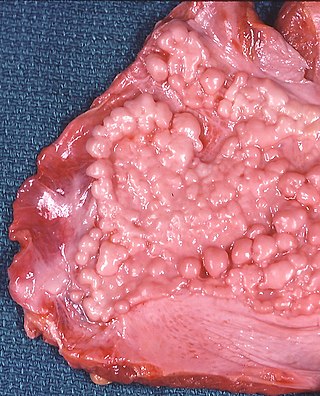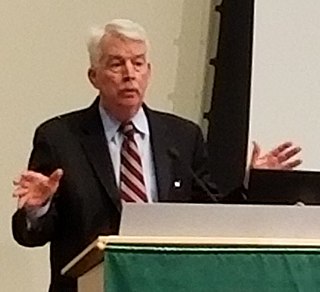Related Research Articles

Mesothelioma is a type of cancer that develops from the thin layer of tissue that covers many of the internal organs. The area most commonly affected is the lining of the lungs and chest wall. Less commonly the lining of the abdomen and rarely the sac surrounding the heart, or the sac surrounding the testis may be affected. Signs and symptoms of mesothelioma may include shortness of breath due to fluid around the lung, a swollen abdomen, chest wall pain, cough, feeling tired, and weight loss. These symptoms typically come on slowly.

Asbestosis is long-term inflammation and scarring of the lungs due to asbestos fibers. Symptoms may include shortness of breath, cough, wheezing, and chest tightness. Complications may include lung cancer, mesothelioma, and pulmonary heart disease.

Chrysotile or white asbestos is the most commonly encountered form of asbestos, accounting for approximately 95% of the asbestos in the United States and a similar proportion in other countries. It is a soft, fibrous silicate mineral in the serpentine subgroup of phyllosilicates; as such, it is distinct from other asbestiform minerals in the amphibole group. Its idealized chemical formula is Mg3(Si2O5)(OH)4. The material has physical properties which make it desirable for inclusion in building materials, but poses serious health risks when dispersed into air and inhaled.
The mineral asbestos is subject to a wide range of laws and regulations that relate to its production and use, including mining, manufacturing, use and disposal. Injuries attributed to asbestos have resulted in both workers' compensation claims and injury litigation. Health problems attributed to asbestos include asbestosis, mesothelioma, lung cancer, and diffuse pleural thickening.
An occupational disease or industrial disease is any chronic ailment that occurs as a result of work or occupational activity. It is an aspect of occupational safety and health. An occupational disease is typically identified when it is shown that it is more prevalent in a given body of workers than in the general population, or in other worker populations. The first such disease to be recognised, squamous-cell carcinoma of the scrotum, was identified in chimney sweep boys by Sir Percival Pott in 1775. Occupational hazards that are of a traumatic nature are not considered to be occupational diseases.
Safety and Health in Agriculture Convention, 2001 is an International Labour Organization Convention.
Workers' Memorial Day, also known as International Workers' Memorial Day or International Commemoration Day for Dead and Injured, takes place annually around the world on April 28, an international day of remembrance and action for workers killed, disabled, injured, or made unwell by their work. In Canada, it is commemorated as the National Day of Mourning.
The Basic Occupational Health Services are an application of the primary health care principles in the sector of occupational health. Primary health care definition can be found in the World Health Organization Alma Ata declaration from the year 1978 as the “essential health care based on practical scientifically sound and socially accepted methods, (…) it is the first level of contact of individuals, the family and community with the national health system bringing health care as close as possible to where people live and work (…)”.

Philip John Landrigan, is an American epidemiologist and pediatrician. He has campaigned against substances in the environment that are harmful to children, such as lead and asbestos. He is also concerned with environmental pesticides.
On June 29, 2008, the XVIII World Congress on Safety and Health at Work signed the Seoul Declaration on Safety and Health at Work. The declaration included statements concerning national governments' responsibility for perpetuating a "national preventive safety and health culture", for improving their national safe-workplace performance systematically, and for providing a health standard with appropriate enforcement to protect workers. The declaration also listed responsibilities of employers, stated the rights of workers, and emphasized the importance of promoting a culture of safety.

Asbestos is a naturally occurring fibrous silicate mineral. There are six types, all of which are composed of long and thin fibrous crystals, each fibre being composed of many microscopic "fibrils" that can be released into the atmosphere by abrasion and other processes. Inhalation of asbestos fibres can lead to various dangerous lung conditions, including mesothelioma, asbestosis, and lung cancer. As a result of these health effects, asbestos is considered a serious health and safety hazard.
An occupational fatality is a death that occurs while a person is at work or performing work related tasks. Occupational fatalities are also commonly called "occupational deaths" or "work-related deaths/fatalities" and can occur in any industry or occupation.
The WHO collaborating centres in occupational health constitute a network of institutions put in place by the World Health Organization to extend availability of occupational health coverage in both developed and undeveloped countries. The effort includes 64 collaborating centres that have been designated as such by the WHO director-general. The centres in the network meet triennially to develop work plans for advancing occupational health in key areas. The 2009-2012 work plan includes 220 projects, which relate to 5 objectives and 14 priorities as outlined by a global plan of action for workers' health.
The Collegium Ramazzini is an independent, international academy composed of physicians, scientists, and scholars from 35 countries. Through its members and activities, it seeks to advance occupational and environmental health by bridging scientific knowledge with socio-political centers that have the responsibility to protect public health. The organization is named after physician Bernardino Ramazzini (1633–1714), known as “the father of occupational medicine.”

Occupational safety and health (OSH) or occupational health and safety (OHS) is a multidisciplinary field concerned with the safety, health, and welfare of people at work. OSH is related to the fields of occupational medicine and occupational hygiene and aligns with workplace health promotion initiatives. OSH also protects all the general public who may be affected by the occupational environment.

Hierarchy of hazard control is a system used in industry to prioritize possible interventions to minimize or eliminate exposure to hazards. It is a widely accepted system promoted by numerous safety organizations. This concept is taught to managers in industry, to be promoted as standard practice in the workplace. It has also been used to inform public policy, in fields such as road safety. Various illustrations are used to depict this system, most commonly a triangle.

Linda Reinstein is the co-founder of the Asbestos Disease Awareness Organization (ADAO), a nonprofit focused on asbestos awareness and preventing related diseases through education, advocacy, and community efforts.
The New York and New Jersey Education and Research Center is one of eighteen Education and Research Centers funded by the National Institute for Occupational Safety and Health (NIOSH). The NYNJERC was established in 1978.

The Mount Sinai Selikoff Centers for Occupational Health are a set of occupational and environmental health clinics that focus on the prevention, diagnosis, and treatment of workplace injuries and illnesses. Significant injuries and illnesses that are treated at the clinical centers include occupational lung cancers, manganese/silica/lead exposures, and asbestos-related illness, which was the career-long research of Dr. Irving Selikoff, the centers' inaugural director. The Selikoff Centers for Occupational Health's multidisciplinary health care team includes physicians, nurse practitioners, industrial hygienists, ergonomists, social workers, and benefits specialists, who are "leaders in the prevention, diagnosis and treatment of workplace injuries and illnesses," and provide comprehensive patient-centered services in New York City and Lower Hudson Valley. The clinical centers are located within the Icahn School of Medicine at Mount Sinai under the Division of Occupational and Environmental Medicine.

Nikolai Fedotovich Izmerov was a Soviet and Russian occupational hygienist and public figure, who made significant contributions to occupational hygiene.
References
- ↑ http://www.icohweb.org/site/multimedia/core_documents/pdf/centennial_declaration.pdf [ bare URL PDF ]
- ↑ LaDou, Joseph (2004-03-01). "The Asbestos Cancer Epidemic". Environmental Health Perspectives. 112 (3). US National Institute of Environmental Health Sciences: 285–290. doi:10.1289/ehp.6704. PMC 1241855 . PMID 14998741. Archived from the original (abstract page) on 2007-10-15. Retrieved 2006-08-03.
- ↑ "Asbestos ban – ICOH".
- ↑ Scandinavian Journal of Work, Environment and Health 1997;23:p.311–6, "Asbestos, asbestosis, and cancer: the Helsinki criteria for diagnosis and attribution. Proceedings of an International Expert Meeting". People and Work. Research Reports 14. Finnish Institute of Occupational Health 1997. 98 p.
- ↑ http://www.icohweb.org/site/multimedia/core_documents/pdf/constitution_eng.pdf [ bare URL PDF ]
- ↑ http://www.icohweb.org/site/multimedia/core_documents/pdf/bye_laws_eng-2022.pdf [ bare URL PDF ]
- ↑ http://www.icohweb.org/site/multimedia/code_of_ethics/code-of-ethics-en.pdf [ bare URL PDF ]
- ↑ http://www.icohweb.org/site/multimedia/core_documents/pdf/ICOH%20-%20Good%20Association%20Practice%202009.pdf [ bare URL PDF ]